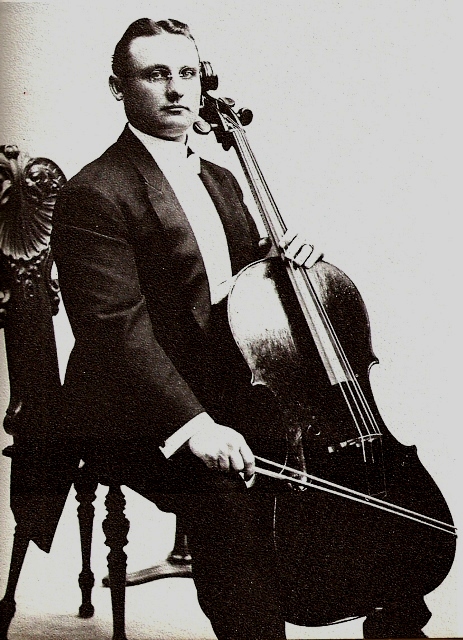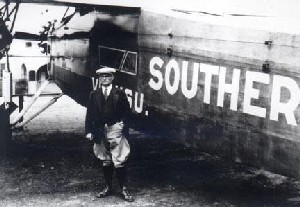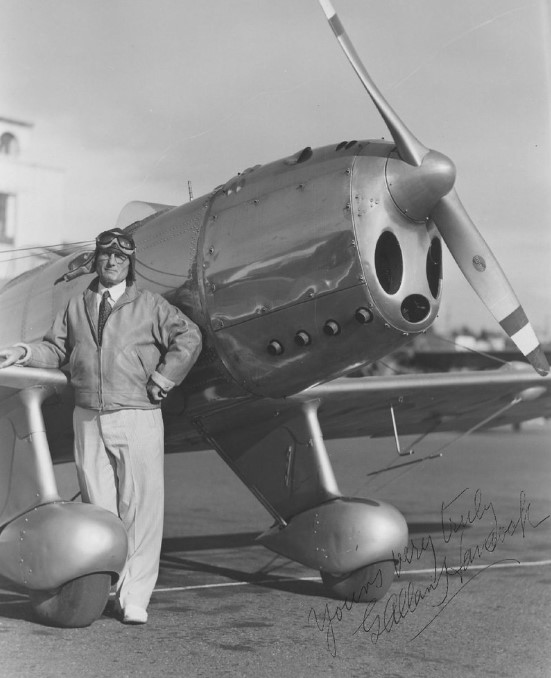Capt. G. Allan Hancock
 Capt. G. Allan Hancock was a sea captain, oilman, explorer, developer, banker, aviator,
scientist, businessman, farmer, railroad engineer, musician, and philanthropist.
Capt. G. Allan Hancock was a sea captain, oilman, explorer, developer, banker, aviator,
scientist, businessman, farmer, railroad engineer, musician, and philanthropist.
He is perhaps best known in the Santa Maria Valley for the college that bears his name. Allan Hancock College stands on the site of the former Hancock College of Aeronautics founded by Capt. Hancock, where thousands of pilots trained for service during World War II.
Capt. Hancock's involvement with the Santa Maria Valley began in earnest in the 1920s when he started an experimental crop irrigation program on a 400-acre farm, raising corn and alfalfa as feed for cattle. The farm was eventually expanded to more than 5,000 acres.
Capt. Hancock also bought and expanded the Santa Maria Valley Railroad, which was originally constructed in 1911 for transport of asphalt from a refinery at Betteravia to Guadalupe, connecting there to the main railroad line. Hancock developed a 29-mile system of railroad right-of-way and tracks and turned the Santa Maria Valley Railroad into the busiest short line railroad system in the country. The railroad still operates between Santa Maria and Guadalupe, and is used for transportation of feed to Rosemary Farm, Hancock's egg-production facility that lies just east of Santa Maria, which Hancock founded in 1925 and named for his daughter.
His passion for aviation developed while he still lived in Los Angeles. That led to the founding of the Hancock College of Aeronautics--not long after he financed the 1928 flight of the "Southern Cross," which made the first historic non-stop flight across the Pacific Ocean. Hancock built the aviation school and private airport on 200 acres within Santa Maria's city limits, opening it in 1929.
In 1939, Gen. Henry "Hap" Arnold, chief of the Army Air Corps, requested that Hancock's school be used to train pilots for the Army. Germany's Luftwaffe then ruled the skies over Europe, and the U. S. had few pilots and no aviation training facilities. Between July 1, 1939, and June 30, 1944, more than 8,400 aviation cadets and student officers were trained at the Hancock College of Aeronautics.
After the war ended, the school was rented for $1 per year to the University of Southern California (USC), which then offered a four-year degree in aeronautical engineering at Hancock's aviation school.
In 1954, Hancock leased the aviation school site to Santa Maria Junior College for $1 per year. Before then, the college, founded in 1920, had conducted cramped classes at Santa Maria High School. Four years later, voters approved a bond measure that financed the purchase of the land and facilities, and construction of the first new buildings at the college campus, which was renamed Allan Hancock College.
Looking Back
In 1857, Capt. Hancock's maternal grandfather, Agoston Haraszthy, a Hungarian count, founded California's first winery, Buena Vista Winery, in Sonoma County. In the early 1860s, Hancock's father, a Harvard University-educated attorney who came to California to mine gold, purchased the 4,438-acre Rancho La Brea land grant near Los Angeles for $2.50 per acre. The property later became Hollywood and Los Angeles' well-known Wilshire District. The La Brea tar pits were part of the Hancock homestead in an area that is today called Hancock Park.
Capt. Hancock was born July 26, 1875, in San Francisco, one of three sons of Maj. Henry Hancock and Haraszthy's daughter, Ida. A twin brother died in infancy. Not long after that, the family moved to Rancho La Brea. Hancock was just eight years old when his father died, leaving his mother to run the family ranch and raise two young boys. In those days, the ranch was far removed from Los Angeles' more civilized areas. The young Hancock helped meet family expenses by digging tar and hauling it from the tar pits for roofing.
In 1900, Ida granted a 20-year lease to the Salt Lake Oil Company for 1,000 acres of Rancho La Brea. Millions of barrels of oil were produced annually. Then, in 1907, with the assistance of William Orcutt (for whom the community of Orcutt, just south of Santa Maria, is named), Hancock drilled 71 wells of his own near the family's ranch house. Every well produced oil, and the Rancho La Brea Oil Company was born. The family's finances improved greatly with the beginning of oil pumping. The wells produced millions of barrels annually and the family became very wealthy. With that wealth, Capt. Hancock was able to pursue myriad interests and thus began a life of philanthropy.
Among his many interests was an appreciation for transportation of various types. He was the second person in Los Angeles to buy an automobile, and was one of nine founders of the Automobile Club of Southern California. He also was a locomotive engineer.
During his youth, Hancock rowed a flatboat on lakes at the tar pits in Los Angeles, and later designed and built several elite ocean-going vessels. After he bought his first yacht, he passed the exam in San Francisco for a master mariner's license, which authorized him to captain a vessel of any size. Thus he became "Captain" Hancock.
Four of his ships, all named Velero (Spanish for sailboat), were used for scientific expeditions along the coasts of Central and South America and other areas over the span of several decades. Some of the earliest expeditions to the Galapagos Islands were made aboard Velero III, and Velero IV, built in 1948, was used to pioneer some of the first deep-sea photography and test runs for the first deep-diving benthoscope, a device developed for deep undersea exploration. Velero IV was still in use by USC researchers more than 30 years after its maiden voyage.
Hancock had a long association with USC, still home to the Hancock Institute of Marine Studies. He served as president and chairman of the USC board of trustees from 1939 to 1954 and later was elected as a life member of the board.
Oil and the wealth it generated provided Hancock with the means to pursue many interests. In 1909, he put up capital used to incorporate the Hibernian Savings Bank, which became the United California Bank. In 1913, Hancock donated the La Brea tar pits to the Los Angeles County Museum of History, with the stipulation that the museum would be free to the public.
Hancock's interest in music started when he was a boy. His first instrument was a harmonica. He became an accomplished cellist, and played cello for many Los Angeles Symphony Orchestra concerts. He later founded the Hancock Ensemble, which played hundreds of concerts up and down the Pacific Coast, from as far north as British Columbia to as far south as Peru.
Hancock gave an informal morning concert at his home on Rosemary Farm property hours before he died in his sleep of heart failure on May 31, 1965.
His wife, Marian Hancock, for whom Allan Hancock College's Marian Theatre is named, continued his legacy of public service for many years. She died in 1993.
Following is a reprint of a Santa Maria Times article of 2-13-05 by Sally Cappon. This was the fifth of 12 monthly installments in a year-long series commemorating Santa Maria's centennial. Parts of the series were collected into a keepsake booklet published by the Santa Maria Times in spring 2005.
Allan Hancock rose from tar pits to wild blue yonder
 Captain Allan Hancock stands with the Southern Cross, bought and overhauled by Hancock,
the first plane to complete a trans-Pacific flight. After a stop in Santa Maria, the
plane took off from Oakland on May 31, 1928. After stops at Hawaii and Fiji, it arrived
in Brisbane, Australia - 8,000 miles later - on June 8. In 1930, the plane came home
to a hero's welcome in Santa Maria.
Captain Allan Hancock stands with the Southern Cross, bought and overhauled by Hancock,
the first plane to complete a trans-Pacific flight. After a stop in Santa Maria, the
plane took off from Oakland on May 31, 1928. After stops at Hawaii and Fiji, it arrived
in Brisbane, Australia - 8,000 miles later - on June 8. In 1930, the plane came home
to a hero's welcome in Santa Maria.
By the time he came to Santa Maria in 1925, Allan Hancock was already a wealthy man.
Nearing 50 years old, he was ready for a new challenge. A return to the country life he'd known as a boy appealed to him.
He'd done it all. Though he had been born in San Francisco - a twin brother died in infancy - he'd grown up in rural Los Angeles. His father, a surveyor, obtained 3,000 acres of Rancho La Brea at a bargain price in exchange for his work - a common practice in the money-strapped town of 3,000.
Money was often tight. The home, amid blue gum and pepper trees, was modest. Allan and a younger brother, Bertram, walked three miles to the nearest school.
A few years later his father died. That left their mother, who was not averse to using a gun to run off squatters, to manage. There was a curious patch of pitchy tar on the property. From it, Allan dug "brea," a dry bitumen which was used for fuel, and hauled it by wagon to Los Angeles, several miles away, where it sold for $2.50 to $4 a ton.
When a nearby oil discovery sparked a mini-oil rush, Allan's mother negotiated a lease for drilling. It was a dry hole, and it took 15 years before she tried again. Another lease negotiated in 1900 proved more successful, bringing in a small but steady income.
Tragically, during this time Hancock's 16-year-old brother Bertram died of typhoid fever.
Striking it rich
Hancock was more than 30 years old and married with a daughter, Rosemary, and young son, Bertram, when he persuaded his mother to finance a wildcat well in a new spot. That well produced oil - and Hancock was on his way.
A photo of the area from 1921 counted 71 oil wells on the Rancho La Brea property.
From there, everything turned to gold for the family.
Hancock's mother built a magnificent home on Wilshire Boulevard, which ran through the old property. Hancock developed Wilshire's Miracle Mile. He founded the California Bank, which became United California Bank.
Always interested in transportation, he bought the second car in California, and was a founder and the first president of the Automobile Club of Southern California. He developed Hancock Park and gave to the city of Los Angeles the curious tar pits - which turned into a rich mother lode of Pleistocene-era fossils.
Many of the early discoveries there were made by William Orcutt, a geologist for whom the community of Orcutt was named. Hancock also acquired a series of marine research ships, which he took to the Galapagos Islands and elsewhere to pick up rare scientific specimens, earning him the lifelong title of Captain.
Looking north
And now, with Los Angeles building up, this remarkable man landed in Santa Maria.
An English syndicate had oil wells east of town, which Hancock was interested in. With the Santa Maria Oil Field came a rundown railroad begun in 1911 to haul out the heavy petroleum from the head of the valley. It ran north from Roadamite to Gates, then west to Santa Maria and on to Guadalupe, where it linked up with the Southern Pacific.
But first Hancock did his homework. He studied the community of 4,000 thoroughly. Who lived there? How did they make their living? No detail escaped him. He studied the soil, determined to "develop the valley agriculturally, scientifically and commercially," according to a 1932 biography of Hancock, "A Pioneer Heritage," by Sam T. Clover.
Believing the clean, orderly town had potential, he began operating the Dominion Oil Co. He also purchased 400 acres a mile east of town, which he named Rosemary Farm for his daughter, and set to work improving the railroad, which Clover described as "two streaks of rust."
Family tragedy
On June 28, 1925, Hancock's son Bertram, then 22, wanted to look over a ranch near Rosemary Farm for cattle raising, giving up his earlier acting ambitions - much to his parents' relief. He and his father drove separately from Los Angeles to Santa Maria, agreeing to spend the night at the elegant Arlington Hotel in downtown Santa Barbara. Hancock, arriving first, took two rooms assigned by the night clerk.
The hotel manager, learning the identity of the guests, and fearing the rooms weren't worthy of them, sent a porter to move them to tower suites. Allan Hancock was a modest man and accepted the change without complaint. Bertram arrived and took the suite next door. Father and son said goodnight, making plans to have breakfast at half past seven the next morning.
That morning, at 6:45 a.m., a 6.3 earthquake unleashed its fury on Santa Barbara. A large water tank concealed in the tower broke loose and crashed into the suite below, crushing Bertram. His father fell two stories in the cataclysm and was critically injured.
He told a friend, "In that frightful moment when the walls fell out and I was hurled through space, I caught a vivid, never-to-be forgotten glimpse of my son's bed plunging downward in the roaring mass and twisted steel." A steel rod impaled Hancock's shoulder and barely missed vital organs, but his injuries affected his speech the rest of his life.
Hancock's wife, Genevieve, distraught at her son's death, closed the Wilshire mansion. Before it was razed a decade later, four rooms, including an elaborate music room, were moved intact to the Allan Hancock Foundation Building on the USC campus, which housed Hancock's scientific finds.
New energy
Santa Maria may have been therapeutic for Hancock. He improved the small railroad, putting in new ties, rebuilding the roadbed and buying new rolling stock. He learned to drive a locomotive, and the railroad became the busiest short line in the country.
He bought and greatly enlarged a local ice-making plant, a key to transporting local vegetables. At Rosemary Farm, he employed the most modern scientific techniques in growing vegetables and in the dairy operation. An egg-producing facility is still in operation today.
A musician since childhood - a harmonica was his first instrument and he later played cello with the Los Angeles Symphony - he was delighted to find an informal musical group meeting at the South Broadway home of Robert Easton. He proposed starting a community orchestra. It was organized in 1926 under William Strobridge, a former business manager of the Los Angeles Symphony, who had come to Santa Maria with Hancock's enterprises.
One of the first concerts, in which Hancock played the cello, was a benefit for the Minerva Club, raising funds for its new clubhouse at Lincoln and Boone streets. The clubhouse - designed by Julia Morgan, the architect for Hearst Castle - opened in 1928.
He built the Little Theater, with seating for 200, on McClelland Street next to the railroad office, installing his own Aeolian pipe organ, and started the city's first radio station.
By 1930, five years after Hancock arrived, the population of Santa Maria had nearly doubled to 7,000.
Getting airborne

In the late 1920s, he turned to aviation. Charles Lindbergh had conquered the Atlantic. Now two men, Charles Kingsford-Smith, an Australian flying ace, and Charles Ulm of San Francisco, wanted to do the same in the Pacific.Seeing that they were passionate and capable but hopelessly underfunded, Hancock bought and overhauled their plane, the Southern Cross.
He also talked them into adding a navigator and radioman.
The Southern Cross, after a stop in Santa Maria, took off from Oakland for the Trans-Pacific flight May 31, 1928. After stops at Hawaii and Fiji, it arrived in Brisbane, Australia - 8,000 miles later - on June 8. Characteristically, Hancock cabled the men, congratulating them and giving them the plane back - at no cost. In 1930, after a world tour, the plane and pilots came home to a hero's welcome in Santa Maria.
Fulfilling another dream, Hancock bought 80 acres of Tunnell flatland east of town, scraped off a runway, built hangars and a dormitory and began the Hancock College of Aeronautics as a memorial to his son Bertram. Starting with five planes, he wanted to teach young men to fly.
After learning that it cost the government $25,000 to train a pilot, he kept the price down to $4,500 so more could afford it. The first class graduated in 1930.
It was a boon to an economy plunging into a tailspin. Santa Maria, like much of America, suffered through the Great Depression. The aeronautical school closed down for a time in 1934.
Hard times, high spirits
Baseball and Hollywood kept spirits up during that grim time. Santa Maria had long been a baseball town, with numerous successful teams, and people followed the statistics of Babe Ruth and Lou Gehrig. People flocked to Harry Dorsey's Gaity Theater and his splendid new Santa Maria Theater, which opened in 1928 with a showing of Buster Keaton's "Steamboat Bill."
There were also local sports heroes. Swimmer John Paulson, just 17, and a Santa Maria High School senior, superbly trained by Paul Nelson at the Santa Maria Plunge, became the city's first Olympic athlete, competing in the 1932 Olympic games in Los Angeles.
President Franklin Roosevelt's New Deal created new job programs and it was a happy day when Santa Maria got word in December 1933 that federal funds were granted for a new City Hall. The city wasted no time, breaking ground Jan. 1, 1934. Mayor Marion Rice presided over the first City Council meeting in the new Spanish-style structure that November.
The city itself had taken flight.
